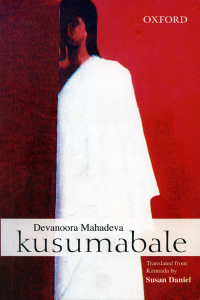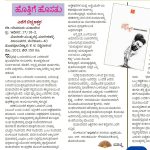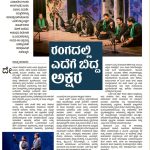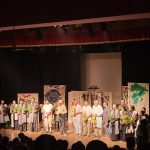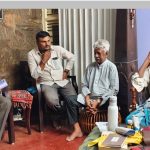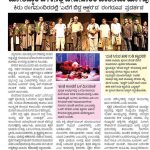Helen Dwyer, Poet & Chairperson Irish Writer’s Union -About KUSUMABALE,
[This is the opinion of Helen Dwyer, poet & Chairperson Irish Writers union-about Devanuru Mahadeva’s Kusumabale. Many thanks to S.R.Ramakrishna. senior journalist who has Translated the opinion to kannada.
ಹೆಲೆನ್ ಡ್ವೈರ್, ಕವಿ ಮತ್ತು ಐರಿಶ್ ಬರಹಗಾರರ ಒಕ್ಕೂಟದ ಅಧ್ಯಕ್ಷರು, ಮಹಾದೇವರ ‘ಕುಸುಮಬಾಲೆ’ ಇಂಗ್ಲೀಷ್ ಅನುವಾದಿತ ಕೃತಿ ಕುರಿತು ನೀಡಿದ ಅಭಿಪ್ರಾಯ. ಅದನ್ನು ಕನ್ನಡಕ್ಕೆ ಅನುವಾದಿಸಿ ಕೊಟ್ಟ ಹಿರಿಯ ಪತ್ರಕರ್ತರಾದ ಎಸ್.ಆರ್.ರಾಮಕೃಷ್ಣ ಅವರಿಗೆ ನಮ್ಮ ಬನವಾಸಿಯ ಧನ್ಯವಾದಗಳು]
I very much enjoyed reading this lyrical, poetic work which flows so smoothly one wants to read on and on. I was sorry when I came to the end of the story. I found the prose to be charmingly imaginative in a manner reminiscent of tales from Irish folklore.
The clever use of personification literally brings this tale to life. The bedstead speaks to us of her days of pampering and days of neglect, reminding us of parallels in everyone’s life, the good times and bad times that we all enjoy or endure.
The writer paints pictures for us with phrases rich in evocative imagery: ‘The room became an ear’, ‘His eyes opened as wide as the village’, ‘Eery filled love into her piety’.
There are delightful flashes of humour, ‘… a nose so big it could sniff out scents from the past’.
I will not forget the beauty of passages such as, ‘It being near midnight and water and stone melting away’, as well as, ‘A ring so pretty you could kiss it with your eyes’.
Both in light-hearted and in serious passages I sense an unworldly quality which elevates this work to the mythical, mystical, archetypal genre.
On reading this story I felt I had been given the privilege of an insight into Indian village life, which differs very little from Irish village life. The same characters raise their heads and have their say in India as in Ireland.
It was a pleasure to read this tale and I would love to see it as a play performed on stage. The author’s rich use of language enables me to visualise the setting and the many intriguing characters. Thanks to the author’s skilful exposition I feel I have met each character face to face.
______________________________________________________
ಓದುತ್ತಲೇ ಇದ್ದು ಬಿಡಬೇಕು ಎನಿಸುವಷ್ಟು ನವಿರಾಗಿ ಹರಿಯುವ ಈ ಗೀತಾತ್ಮಕ ಕಾವ್ಯ ಕೃತಿ ನನಗೆ ಬಹಳ ಖುಷಿ ಕೊಟ್ಟಿದೆ. ಕಥೆ ಕೊನೆಯಾದಾಗ ಬೇಸರವೇ ಆಯಿತು. ಇಲ್ಲಿನ ಗದ್ಯ ಚೆಲುವಾದ ಕಲ್ಪನೆಯಿಂದ ಕೂಡಿದ್ದು, ಐರಿಶ್ ಜಾನಪದ ಕಥೆಗಳನ್ನು ನೆನಪಿಗೆ ತರುತ್ತದೆ.
ವಸ್ತುಗಳಿಗೆ ವ್ಯಕ್ತಿ ಗುಣ ಲಕ್ಷಣಗಳನ್ನು ಹಚ್ಚುವ ಜಾಣ್ಮೆಯಿಂದ ಈ ಕಥೆ ಜೀವ ತಾಳುತ್ತದೆ. ಮಂಚ ತಾನು ಮುದ್ದುಗರೆಸಿಕೊಳ್ಳುವ ದಿನಗಳ ಬಗ್ಗೆ ಮತ್ತು ಅವಗಣನೆಗೆ ಒಳಗಾಗುವ ದಿನಗಳ ಬಗ್ಗೆ ಹೇಳಿಕೊಂಡಾಗ ನಾವೆಲ್ಲರೂ ಸುಖಿಸುವ ಒಳ್ಳೆಯ ದಿನಗಳು ಮತ್ತು ತಾಳಿಕೊಳ್ಳುವ ಕೆಟ್ಟ ದಿನಗಳನ್ನು ಜ್ಞಾಪಿಸುತ್ತಾಳೆ.
ಬರಹಗಾರರು ಶ್ರೀಮಂತ ಪ್ರತಿಮೆಗಳನ್ನು ಬಳಸಿ ಚಿತ್ರಗಳನ್ನು ಕಟ್ಟಿಕೊಡುತ್ತಾರೆ:
‘’ಕಿರುಮನೆಯು ಕಿವಿಯಾಗಿತ್ತು’’
“ಅವಳು ಬಾಚ್ಕಟ್ಟಿದ್ದ ತುದಿಗೂದಲ ಕೆಂಚೆಲ್ಲವೂ ಒಕ್ಕಡವಾಗಿ, ಆ ಎಣಗಂಟು ಬೆಂಕಿ ಕೆಂಡ್ವಾಗಿ ಕಾಣ್ತಾ,
ಆ ಕೆಂಡವಾಗಿ ಇದ್ದುದರ ಮ್ಯಾಲ ಮೂರು ಹೂಗಳು ನೆಗ್ತ ಕೂತಿದ್ದವು”
ಹಾಸ್ಯದ ಹೊಳಹುಗಳು ಮುದಗೊಳಿಸುವಂತಿವೆ:
“ಆ ಗತ ಕಾಲದ ವಾಸ್ನನೂ ಹಿಡಿಬಹುದಾದಷ್ಟಿದ್ದ ಮೂಗುವಿ”
ಕೆಲವು ಸಾಲುಗಳ ಸೌಂದರ್ಯವನ್ನು ಮರೆಯಲಾರೆ:
“ಕಲ್ಲೂ ನೀರು ಕರಗುತ್ತಿತ್ತು”
“ಕಾಲ್ಬೆರಳಲ್ಲಿ ಕಣ್ಣುಗೊತ್ತುಕೊಳ್ಳುವಷ್ಟು ಚಂದದ ಪಿಲ್ಲಿ ಹಾಕಂಡೂ”
ಈ ಕೃತಿಯ ಹಗುರ ಹಾಗೂ ಗಂಭೀರ ಸಾಲುಗಳಲ್ಲಿ ಕಾಣುವ ಅಲೌಕಿಕ ಗುಣ ಇದನ್ನು ಪುರಾಣದ, ಅತೀಂದ್ರಿಯದ, ಆರ್ಕಿಟೈಪಲ್ ಮಟ್ಟಕ್ಕೆ ಏರಿಸುತ್ತದೆ.
ಓದುತ್ತಿದ್ದಂತೆ ಐರಿಶ್ ಹಳ್ಳಿಗಿಂತ ಅಷ್ಟೇನೂ ಭಿನ್ನವಲ್ಲದ ಭಾರತೀಯ ಹಳ್ಳಿಯೊಂದರ ಜೀವನದ ಒಳನೋಟ ನನಗೆ ಸಿಕ್ಕಂತೆ ಭಾಸವಾಯಿತು. ಐರ್ಲೆಂಡ್ ನಲ್ಲಿರುವಂಥ ಪಾತ್ರಗಳೇ ಭಾರತದಲ್ಲೂ ತಲೆಯೆತ್ತಿ ಮಾತಾಡುತ್ತವೆ. ಓದುವ ಸಂತೋಷದ ಜೊತೆಜೊತೆಗೆ ಈ ಕೃತಿಯನ್ನು ರಂಗಪ್ರಯೋಗವಾಗಿ ನೋಡುವ ಹಂಬಲವೂ ನನ್ನಲ್ಲಿ ಮೂಡಿದೆ. ಇಲ್ಲಿನ ಸಂಪದ್ಭರಿತ ನುಡಿ ಪ್ರಯೋಗದಿಂದ ರಂಗಸಜ್ಜಿಕೆ ಮತ್ತು ಪಾತ್ರ ಕುತೂಹಲಗಳನ್ನು ಊಹಿಸಿಕೊಳ್ಳಲು ನನಗಾಗಲೇ ಸಾಧ್ಯವಾಗಿದೆ. ಬರಹಗಾರರ ಕಥನ ಕೌಶಲ್ಯವು ಪ್ರತಿಯೊಂದು ಪಾತ್ರವನ್ನೂ ನಾನೇ ಸ್ವತಃ ಕಂಡಂತೆ ಮಾಡಿದೆ.


